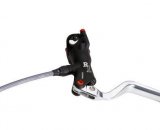Tim Cannard adapted his Formula R1 hydraulic brakes for road brake lever and drop bar. © Cyclocross Magazine
With the recent UCI ruling allowing disc brakes in cyclocross, and USA Cycling’s subsequent adoption of the rule for the 2010 Cyclocross National Championships, a number of disc brakes will be out on the course. Almost all will be cable-pull models connected to typical cable-pull drop bar shift / brake levers like Shimano STI levers or SRAM DoubleTap, or just aero cable-pull brake levers in the case of singlespeeds.
Buy-Cell / Ibis racer and team director Tim Cannard will be the exception. Cannard raced the non-title singlespeed race last year in Bend on his Ibis Tranny with a rigid Niner fork, 29er wheels, a flat bar, fat Schwalbe Furious Fred tires and his beloved hydraulic disc brakes. With the last-minute emergency singlespeed legislation that made the singlespeed a title race but required drop handlebars (and maximum tire 35c tire widths), Cannard knew he had to make some last-minute adjustments to ride his favorite bike and brakes of choice (he does own a whopping six cyclocross bikes but still prefers the Tranny). Somehow he needed to figure out away to adapt his hydraulic brakes to his cable-pull drop bar levers. “Three nights and 24 beers later, I figured it out,” he told Cyclocross Magazine.
Standard Cane Creek brake levers connected to Formula R1 hydraulic disc brakes. © Cyclocross Magazine
Cannard and his business partner Denzil Wessels developed what he’s affectionately calling the “324” (for his time and hydration investment in the invention), an aluminum clamp and adapter to allow his Cane Creek drop bar levers to actuate his Formula R1 hydraulic disc brakes and master cylinder. Cannard constructed the clamp to mount the existing R1 master cylinder assembly and clamp parallel to the handlebar, and essentially chopped and modified the old R1 brake lever to instead clamp and be pulled by a road brake cable.
The result is the stopping power and modulation of hydraulic disc brakes available to any road bike brake lever, with a weight gain over the svelte flat bar Formula R1 hydraulic brake setup (as light as 263 grams, claimed to be the world’s lightest) equal to just the brake levers. Compared to a lightweight cantilever setup, he might have a half pound penalty, but in the unpredictable conditions of Bend, the extra weight is worth it for Cannard, who says his Tranny complete with Tufo tubulars weighs about 18 pounds. With a carbon flat bar, before adding the Salsa Bell Lap handlebar and Cane Creek levers, the same bike was just 16.5 pounds. Although Cannard races singlespeed, the adapter would easily work with any “brifter” or aero brake levers with hidden cables (sorry Campy Nuovo Record users).
Cannard is already working to patent the invention and believes the market for such a device is large. “Think about the loaded tourer who with gear has 250 pounds to stop,” Cannard says, as he recalls a cyclo-tourist friend who is always complaining about his brake options. Cyclocrossers, tourers and wet-weather commuters are all potential target customers.
The first 100 will be made from titanium and will fit either the Formula R1 or RX brake, but he plans to eventually use aluminum for the fittings as he did with this prototype. He also plans to support other brakes, including a model from Avid and perhaps Magura.
Stay tuned as Cyclocross Magazine anxiously awaits its test set, just as mud season has finally arrived in Norcal, and look out for Cannard in the singlespeed race as he aims for a top thirty finish.
Photo Gallery:






























